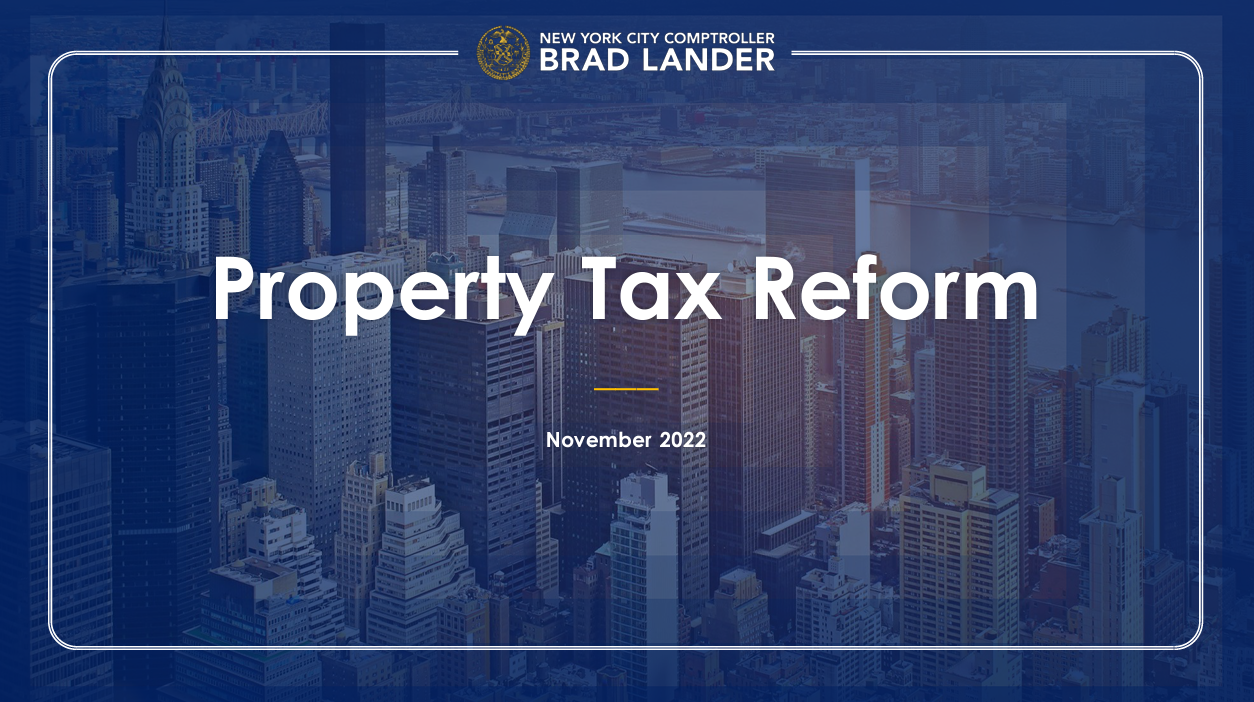NYC Comptroller Outlines Framework for Comprehensive Property Tax Reform

Lander Proposes Bringing Together Long Overdue Reform for Overtaxed Homeowners with Changes to Multifamily Taxation in the Wake of the Expiration of 421-a
Framework Would Bring Fairness and Transparency, Incentivize New Rental Housing Production, Tie Tax Breaks to Actual Affordability, and Include a 21st Century Mitchell-Lama Program for Permanently Affordable Cooperative Homeownership
New York, NY – At a City Council Finance Committee hearing on property taxes Tuesday, New York City Comptroller Brad Lander presented a framework for addressing inequities in NYC’s convoluted property tax system. Lander argued this is a critical moment of opportunity for comprehensive reform to link long overdue relief for overtaxed homeowners with a better way of taxing multifamily development in the wake of the expiration of the 421-a property tax break for new development.
Building on the NYC Advisory Commission on Property Tax Reform’s 2021 recommendations, Lander proposed changes to address an opaque system with gaping inequities between homeowners in different neighborhoods and building types, while including a phase-in and protections for potentially vulnerable homeowners in areas where rates would rise over time.
The Comptroller’s framework would also incentivize new rental housing production by reducing their base tax rate approximately 30% to be on par with condos, and tie tax breaks to the actual cost and affordability of buildings.
In place of the widely-panned “130% AMI” program under 421-a that built subsidized housing unaffordable to the vast majority of residents in those neighborhoods, Lander proposed a new, 21st century version of the Mitchell-Lama program to create permanently affordable, cooperative homeownership for tens of thousands of working New Yorkers.
“New York’s opaque and inequitable property tax system is hurting working families across our city, while inhibiting the housing development our city needs amidst a housing crisis,” said Comptroller Brad Lander. “We have a unique moment this year to solve several problems at once, with structural changes to the tax system to bring fairness and common sense to our city’s largest revenue stream. If we get it right, we can address the unfair burden of high property taxes in the outer boroughs and create new affordable homeownership and rental opportunities that maximize public dollars to bring down costs for New Yorkers.”
Promoting Fairness Among Homeowners
In December 2021, the New York City Advisory Commission on Property Tax reform released a set of recommendations, following eight in-person public hearings during 2018-2019 and five remote public hearings during 2021. Those hearings focused on three core problems with the current tax structure:
- 1-3 family homes, co-ops and condos are not subject to the same rules for valuation. Large rentals are taxed at approximately double the rate of condo and co-ops.
- The system is generally opaque and difficult to understand. Variation in assessment ratios by property type confuses owners and makes the system less transparent.
- The differences in effective tax rates across neighborhoods is too wide. Outer-borough homeowners pay far higher rates than upper- and middle-class Manhattan and brownstone Brooklyn.
Building on the recommendations of the Advisory Commission, the Comptroller made the following recommendations to address those problems:
- Aggregate Class 1, Class 2 condos and coops, and small rentals (up to 10 units) in one class and uniformly value all properties in the class at sales-based market value.
- End fractional assessments and apply one tax rate to the sales-based market value.
- Phase the changes in over five years, with potential consideration of allowing homeowners to defer the higher tax burden until sale of the property, or even waiting until sale to reset the rates.
- Provide a homestead exemption for homeowners who use their property as a primary residence and circuit breakers to protect potentially vulnerable homeowners in areas where rates may rise over time.
A Better Way to Tax Multifamily Development and Subsidize Real Affordability
For forty years, New York State has layered on a patchwork of exemptions and abatements to lower tax rates for developers of multifamily housing, rather than dealing with structural flaws in the property tax system.
The largest of those has been the 421-a tax incentive program, viewed as necessary in large part because NYC taxes rentals at nearly double the rate of condo and coop development. But at $1.77 billion in annual forgone tax revenue, and with widespread fraud, it was far too expensive for the few genuinely affordable units it produced. The Comptroller was among the leading proponents of allowing the 421-a tax abatement to expire in June 2022.
Comptroller Lander outlined structural reforms to taxation of multifamily residential buildings that would better incentivize new rental housing production, tie tax breaks to actual affordability, and include a 21st century Mitchell-Lama program for permanently affordable cooperative homeownership:
- Reduce the tax rate on new large rental buildings by 30%, dramatically reducing the disparity in taxation between new rentals and condos. The lower tax rate makes market-rate rental housing production more possible in core and non-core markets.
- Allow the Department of Housing Preservation and Development (HPD) to underwrite full or partial exemptions for new development based on projected costs and affordability, aligned with HPD’s affordable housing programs, in order to appropriately support development and prevent double-dipping.
- Instead of the outer-borough 130% AMI program in 421-a, which created units unaffordable to most residents of the neighborhoods where it was built, offer a 21st century Mitchell-Lama program, combining tax relief and capital subsidies to provide permanently affordable, multifamily, limited-equity cooperative homeownership at a range of incomes.
The Comptroller’s framework as presented to the City Council is available here.
###